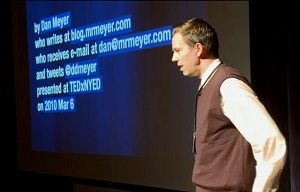Math curriculum needs a makeover and it’s up to education students to take action
According to the 2015 Program for International Student Assessment (PISA), the average math score for U.S. students was 20 points below the international average math score.
“Students are often good at answering the first layer of a problem in the United States,” said Andreas Schleicher, director of education and skills at the Organization for Economic Cooperation and Development (OECD) — the organization that coordinates PISA. “But as soon as students have to go deeper and answer the more complex part of a problem, they have difficulties.”
Former high school math teacher Dan Meyer addresses a similar issue in his TED Talk: Math class needs a makeover. He discusses how much of our society is impatient with things that don’t resolve quickly. We want simple problems with quick and simple answers — and he challenges us that “no problem worth solving is that simple.”
Meyer goes on to state that many of the textbooks we use give away too much of the answers and do not help teach math reasoning and patient problem solving. He states that what we are doing with these textbook problems is “taking a compelling question, a compelling answer, but we’re paving a smooth, straight path from one to the other and congratulating our students for how well they can step over the small cracks in the way.”
At the end of his talk, Meyer leaves math teachers with a few tips for designing better curriculum and for asking better questions that lead to better problem solving:
- Use multimedia — it brings the real world into your classroom
- Encourage student intuition to create a level playing field among students
- Ask the shortest questions possible and let more specific questions come out in conversation
- Let students build the math problem — Albert Einstein states, “The formulation of a problem is often more essential than its solution, which may be merely a matter of mathematical or experimental skill.”
- Be less helpful — when we, or the textbooks we use, try too hard to hold students’ hands through the process, we take away opportunity for patient problem solving and math reasoning
“…people, not just students, are really hungry for this,” explains Meyer. “Math makes sense of the world. Math is the vocabulary for your own intuition. So I just really encourage you, whatever your stake is in education — whether you’re a student, parent, teacher, policy maker, whatever — insist on better math curriculum. We need more patient problem solvers.”
William Woods bachelors in elementary education or middle-level education with a concentration in mathematics will take courses to prepare them to teach math and develop teaching strategies to engage and challenge students of different ages. Courses may include EDU341: Teaching Mathematics (Elementary) and MAT231: Mathematics for Elementary Teachers, where students will learn instructional methods, materials, and evaluation procedures used in teaching mathematics, as well as approaches to improvement of teaching and curriculum.
Students earning their MEd in Curriculum and Instruction will also focus on approaches to analyzing, improving and creating new curriculum in math and other subjects across the board to ensure that their students are being taught in the most effective ways and getting the full value out of their education.


